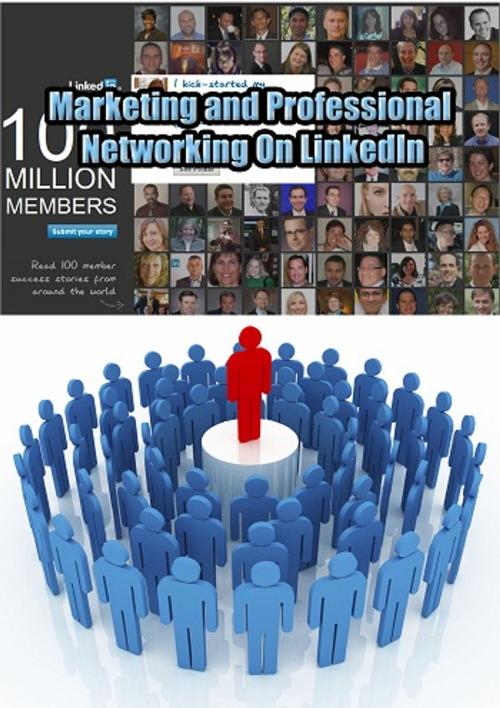Marketing and professional networking On LinkedIn
Best Business Promotion and PR with Linkedin
Business & Finance, Business Reference, Business Communication, Human Resources & Personnel Management| Author: | Karl Laemmermann | ISBN: | 1230000187884 |
| Publisher: | Heinz Duthel | Publication: | October 1, 2013 |
| Imprint: | Language: | English |
| Author: | Karl Laemmermann |
| ISBN: | 1230000187884 |
| Publisher: | Heinz Duthel |
| Publication: | October 1, 2013 |
| Imprint: | |
| Language: | English |
Marketing and professional networking On LinkedIn
One purpose of the site is to allow registered users to maintain a list of contact details of people with whom they have some level of relationship, called Connections. Users can invite anyone (whether a site user or not) to become a connection. However, if the invitee selects "I don't know" or "Spam", this counts against the inviter. If the inviter gets too many of such responses, the account may be restricted or closed.
This list of connections can then be used in a number of ways:
A contact network is built up consisting of their direct connections, the connections of each of their connections (termed second-degree connections) and also the connections of second-degree connections (termed third-degree connections). This can be used to gain an introduction to someone a person wishes to know through a mutual contact.
Users can upload their resume or design their own profile in order to showcase work and community experiences.
It can then be used to find jobs, people and business opportunities recommended by someone in one's contact network.
Employers can list jobs and search for potential candidates.
Job seekers can review the profile of hiring managers and discover which of their existing contacts can introduce them.
Users can post their own photos and view photos of others to aid in identification.
Users can now follow different companies and can get notification about the new joining and offers available.
Users can save (i.e. bookmark) jobs which they would like to apply for.
International reception
In 2009, Syrian users reported that LinkedIn server stopped accepting connections originating from IP addresses assigned to Syria. The company's customer support stated that services provided by them are subject to US export and re-export control laws and regulations and "As such, and as a matter of corporate policy, we do not allow member accounts or access to our site from Cuba, Iran, North Korea, Sudan, or Syria." In February 2011, it was reported that LinkedIn was being blocked in China after calls for a "Jasmine Revolution". It was speculated to have been blocked because it is an easy way for dissidents to access Twitter, which had been blocked previously. After a day of being blocked, LinkedIn access was restored in China.
LinkedIn
Professional network service
Wiki
Blog
Collaborative real-time editor
Prediction market
Social networking service
Social bookmarking
Enterprise bookmarking
Virtual world
Massively multiplayer online game
Online journalism
Initial public offering
Quantcast
Jeff Weiner
Reid Hoffman
Post-money valuation
Dublin
Cryptographic hash function
SlideShare
Dynamo (storage system)
Voldemort (distributed data store)
Social network
Social software
Business networking
Information Routing Group
List of social networking websites
Reputation system
IP address
2011 Chinese pro-democracy protests
Marketing and professional networking On LinkedIn
One purpose of the site is to allow registered users to maintain a list of contact details of people with whom they have some level of relationship, called Connections. Users can invite anyone (whether a site user or not) to become a connection. However, if the invitee selects "I don't know" or "Spam", this counts against the inviter. If the inviter gets too many of such responses, the account may be restricted or closed.
This list of connections can then be used in a number of ways:
A contact network is built up consisting of their direct connections, the connections of each of their connections (termed second-degree connections) and also the connections of second-degree connections (termed third-degree connections). This can be used to gain an introduction to someone a person wishes to know through a mutual contact.
Users can upload their resume or design their own profile in order to showcase work and community experiences.
It can then be used to find jobs, people and business opportunities recommended by someone in one's contact network.
Employers can list jobs and search for potential candidates.
Job seekers can review the profile of hiring managers and discover which of their existing contacts can introduce them.
Users can post their own photos and view photos of others to aid in identification.
Users can now follow different companies and can get notification about the new joining and offers available.
Users can save (i.e. bookmark) jobs which they would like to apply for.
International reception
In 2009, Syrian users reported that LinkedIn server stopped accepting connections originating from IP addresses assigned to Syria. The company's customer support stated that services provided by them are subject to US export and re-export control laws and regulations and "As such, and as a matter of corporate policy, we do not allow member accounts or access to our site from Cuba, Iran, North Korea, Sudan, or Syria." In February 2011, it was reported that LinkedIn was being blocked in China after calls for a "Jasmine Revolution". It was speculated to have been blocked because it is an easy way for dissidents to access Twitter, which had been blocked previously. After a day of being blocked, LinkedIn access was restored in China.
LinkedIn
Professional network service
Wiki
Blog
Collaborative real-time editor
Prediction market
Social networking service
Social bookmarking
Enterprise bookmarking
Virtual world
Massively multiplayer online game
Online journalism
Initial public offering
Quantcast
Jeff Weiner
Reid Hoffman
Post-money valuation
Dublin
Cryptographic hash function
SlideShare
Dynamo (storage system)
Voldemort (distributed data store)
Social network
Social software
Business networking
Information Routing Group
List of social networking websites
Reputation system
IP address
2011 Chinese pro-democracy protests















